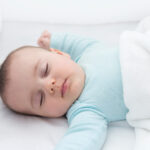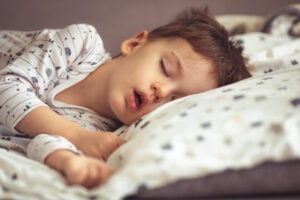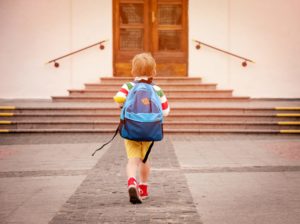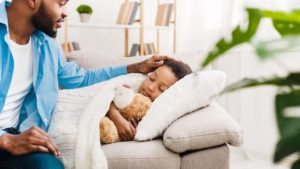When you buy through our links, we may earn a commission. Products or services may be offered by an affiliated entity. Learn more.
Children and Sleep
An introduction to the importance of sleep in children and how to help them sleep better
Sleep is an essential building block for your child’s mental and physical health. But if you’re finding it impossible to help your toddler sleep, you’re not alone. The American Academy of Pediatrics estimates that sleep problems affect 25 to 50 percent of children and 40 percent of adolescents.
Understanding their sleep needs is the first step towards providing better sleep for your children. Through a combination of sleep hygiene, age-appropriate routines, and close attention to any sleep disorders, you can help your child get the rest they need to grow up strong and healthy.
Why Is Sleep Important For Children?
Sleep plays a crucial role in the development of young minds. In addition to having a direct effect on happiness, research shows that sleep impacts alertness and attention, cognitive performance, mood, resiliency, vocabulary acquisition, and learning and memory. In toddlers, napping appears to be necessary for memory consolidation, executive attention, and motor skill development. Sleep also has important effects on growth, especially in early infancy .
What Happens When Children Don’t Get Enough Sleep?
As every parent knows, a child that’s short on sleep can swing between being grumpy and hyperactive, with effects that can mimic ADHD . Sleepiness can also affect your child’s ability to pay attention, with ramifications for their performance in school. Even minimal sleep restriction can have effects on your child’s day-to-day life.
According to the American Academy of Pediatrics (AAP), a quarter of children under the age of 5 don’t get adequate sleep. This is worrying because poor sleep in early childhood has been linked to allergic rhinitis and problems with the immune system, as well as anxiety and depression . There is also emerging evidence that poor sleep in childhood may carry future cardiovascular risks in the form of obesity, diabetes , and high blood pressure.
In adolescents, inadequate sleep can have long-term effects on academic performance and mental health . The American Medical Association, the US Department of Health and Human Services, and the American Academy of Pediatrics consider chronic sleep loss in adolescents to be a public health problem. It is a risk factor for substance abuse and mental health problems, as well as more immediate problems such as car crashes and sports injuries.
Help Your Child Sleep Better With Pediatric Sleep Coaching

our partner at sleepdoctor.com
Learn More“Life-changing! My anxiety about my son’s sleeping habits were immediately reduced after talking to Sara. She went above and beyond to tailor a schedule to our goals, answer our questions, keep us on track, and check in to encourage us when we just thought we couldn’t do it anymore.”
Rachael B. – Verified Customer
Tips on How To Make Sure Your Child Gets a Full Night’s Sleep
Sleep needs change as your child grows older, but whether you’re dealing with a 2-year-old toddler or a stubborn teenager, research shows that a consistent bedtime routine is helpful for making sure your child gets enough sleep. Whatever activities you choose, try to do the same ones every day in the same order so your child knows what to expect.
A typical bedtime routine might include:
- Turning off computers, TV screens, video games, and other bright lights
- Putting on pajamas and brushing teeth
- Reading a light book, singing a lullaby, or taking a bath
- Picking a stuffed animal or security blanket for the night for toddlers
The best time to put your child to bed is when they’re sleepy, not when they’re already asleep. This helps them learn how to fall asleep on their own. If preschool children wake up in the middle of the night, walk them back to their bed. It’s best not to let infants sleep in your bed, as co-sleeping increases the risk of sudden infant death syndrome.
Sleep Hygiene Tips for Kids
Daytime habits also affect sleep. You can promote restful slumber in your children by following basic sleep hygiene rules:
- Arranging a balanced schedule with interspersed periods of rest and play
- Keeping a regular bedtime
- Making the bedroom, and especially the mattress, a no-screen zone, even during the day
- Providing a healthy diet
- Setting the thermostat to a slightly cooler temperature
- Using dark curtains to block out light, or a nightlight if they’re scared of the dark
- Keeping the bedroom quiet, or using a white noise machine to mask outside sounds
- Avoiding caffeine, large meals, and sugary treats before bedtime, opting for a healthy bedtime snack if necessary
It’s important to give your child regular exercise, but don’t fall into the trap of exhausting your child to have them sleep better at night. More often than not, this will make them overtired and actually make it harder to fall asleep. Learn to recognize the special level of hyper that means your toddler is too tired, so you can put them to bed before things turn sour.
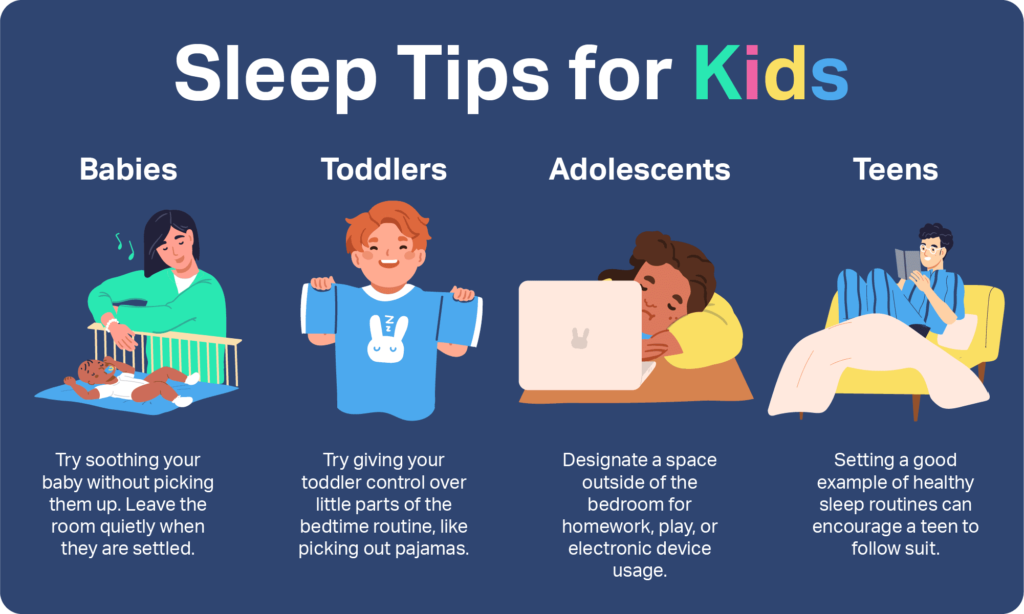
Sometimes, a bedtime routine is easier said than done. For two-parent households or siblings who share a room, bedtime may require extra logistics.
- Sleep tips for babies: Because they have yet to develop a circadian rhythm, very young babies rarely sleep through the night, and that’s ok . If they don’t fall back asleep naturally, try soothing them by talking or with touch, without picking them up. If they continue to cry, they may be hungry or need their diaper changed. Quickly and quietly fix the problem, using only a nightlight if possible, and calmly leave the room.
- Sleep tips for toddlers: Young toddlers have a sleep schedule supplemented by napping during the day. Toddler sleep problems are compounded by separation anxiety and a fear of missing out, which translates to stalling techniques and stubbornness at bedtime. You can cut down on these complaints by giving them control over minor choices like which pajamas to wear or which book to read. Try to be patient, firm, yet loving because power struggles are likely to elicit a stronger response from them.
- Sleep tips for school kids: Between academic, social, and extracurricular obligations, school-age children often have busy schedules that can make it difficult to get a good night’s sleep. Wherever possible, try to follow a consistent schedule and a wind-down period before bed. To strengthen the association between the bedroom and sleep, have them do homework or other activities in another room where possible.
- Sleep tips for teenagers: Teenagers are programmed to have a later circadian rhythm which can create a problem with school start times. You can help your teenager by acknowledging the increased demands on their time and working together to find a healthy sleep schedule that works with their lifestyle. Teenagers appear to imitate their parents to a certain extent when it comes to sleeping, so one of the best things you can do to help them develop a healthy sleep pattern is to keep one yourself.
The morning is important, too. Though it’s tempting to let your kids sleep in on the weekends, this can disrupt their sleep schedule and make it harder to wake up during the week. Try not to overschedule extracurricular activities if you notice these having a detrimental effect on their sleep time.
If you’re practicing healthy sleep hygiene and your child is still feeling sleepy or having trouble falling asleep or staying asleep at night, it might be time to visit a doctor to see if they have a sleep condition. You can also ask their teacher to keep you updated on their attention levels. Difficulty concentrating, hyperactive behavior, or learning problems may indicate they are not getting proper sleep.

Sleep Problems in Children
Issues that might seem minor to us are often very significant to a child, so events like a new sibling, teething, an illness, a different place, a new caregiver, a change in schedule, or minor complaints like allergies, colds, and ear infections can all take their toll on your child’s sleep.
In addition to these common problems, as many as 50 percent of children suffer from sleep disorders at some point. Sleep disorders are intricately intertwined with mental and physical health issues, with one exacerbating the other in a cycle that can be hard to break. Additionally, some sleep disorders are not evident to the sleeper, or they may mirror other conditions such as epilepsy, making them difficult to diagnose .
Some of the most common sleep disorders in children are night terrors and nightmares, sleep apnea, sleep talking and sleepwalking, snoring, and restless leg syndrome.
Night Terrors and Nightmares
Nightmares can be frightening for toddlers, who have a harder time distinguishing what’s real and what’s not. Children often wake up from nightmares, which usually occur during REM sleep. If this happens, offer them reassurance and gently put them back to sleep.
Night terrors, otherwise known as sleep terrors, are a parasomnia that occurs early in the night during non-REM sleep in about one-third of children . Your child may scream and bolt upright during a night terror, but they won’t usually wake up or remember the incident in the morning. The best thing you can do is make sure your child is safe, trying to keep them in bed if possible. There’s no need to wake them up or worry if your child experiences the occasional night terror, but if they become very frequent or if they’re causing daytime sleepiness, they’re worth mentioning to your pediatrician.
Sleep Talking and Sleepwalking
Sleep talking is a relatively common parasomnia involving vocalizations during sleep. Sleep talking appears to occur more frequently during light sleep, so proper sleep hygiene may help reduce episodes. While harmless on its own, sleep talking may disturb other people in the bedroom. It is sometimes connected to other sleep disorders such as nightmares or sleepwalking.
Research suggests that 1 in 3 children will sleepwalk before the age of 13, with most episodes occurring in the pre-teen years. As with sleep talkers, sleepwalkers are not aware of their surroundings and usually have no recollection of their activity afterward. In addition to daytime sleepiness, sleepwalking can have serious consequences depending on the person’s actions. If your child sleepwalks, it’s a good idea to safety-proof their bedroom and install an alarm. Waking someone up about half an hour before their regular sleepwalking episode occurs has proven useful.
Snoring and Sleep Apnea
Just as with adults, it’s normal for children to snore occasionally. Snoring in children may be caused by swollen tonsils or adenoids, allergies, obesity, secondhand smoke, or other factors. However, if you notice your child snoring excessively, or displaying pauses in breathing followed by gasps, they may have sleep apnea.
Children with sleep apnea suffer from disrupted breathing which prompts them to wake up multiple times during the night, often without them realizing. The first clue that something is wrong may be when you notice your child displaying the hallmark signs of sleep deprivation, such as daytime sleepiness, difficulty concentrating, and hyperactivity. Frequent snoring and sleep apnea can both have ill effects on your child’s health and cause disruptions to other members of the family. Talk to your pediatrician about ways to reduce symptoms.
Restless Legs Syndrome
Characterized by an irrepressible urge to move the legs, restless legs syndrome in children can be difficult to identify. You may think your child is simply fidgeting or suffering from growing pains. Treatment of nighttime restless leg syndrome in children includes proper sleep hygiene and stretching before bed. Iron supplements have proven useful in treating adults, but research is still being conducted into the safety and efficacy of iron supplements for children.
If you think your child may be suffering from one of these sleep disorders, keep track of the symptoms in a sleep diary, and talk to your pediatrician. Establishing good sleep hygiene habits and eliminating other barriers to proper sleep is the first line of defense in treating many of these conditions.

Still have questions? Ask our community!
Join our Sleep Care Community — a trusted hub of sleep health professionals, product specialists, and people just like you. Whether you need expert sleep advice for your insomnia or you’re searching for the perfect mattress, we’ve got you covered. Get personalized guidance from the experts who know sleep best.
References
16 Sources
-
Zhou, Y., Aris, I. M., Tan, S. S., Cai, S., Tint, M. T., Krishnaswamy, G., Meaney, M. J., Godfrey, K. M., Kwek, K., Gluckman, P. D., Chong, Y. S., Yap, F., Lek, N., Gooley, J. J., & Lee, Y. S. (2015). Sleep duration and growth outcomes across the first two years of life in the GUSTO study. Sleep medicine, 16(10), 1281–1286.
https://linkinghub.elsevier.com/retrieve/pii/S1389945715008631 -
Knight, F., & Dimitriou, D. (2019). Poor Sleep Has Negative Implications for Children With and Without ADHD, but in Different Ways. Behavioral sleep medicine, 17(4), 423–436.
https://www.tandfonline.com/doi/full/10.1080/15402002.2017.1395335 -
Jernelöv, S., Lekander, M., Almqvist, C., Axelsson, J., & Larsson, H. (2013). Development of atopic disease and disturbed sleep in childhood and adolescence–a longitudinal population-based study. Clinical and experimental allergy : journal of the British Society for Allergy and Clinical Immunology, 43(5), 552–559.
https://onlinelibrary.wiley.com/doi/10.1111/cea.12087 -
Hochadel, J., Frölich, J., Wiater, A., Lehmkuhl, G., & Fricke-Oerkermann, L. (2014). Prevalence of sleep problems and relationship between sleep problems and school refusal behavior in school-aged children in children’s and parents’ ratings. Psychopathology, 47(2), 119–126.
https://www.karger.com/Article/FullText/345403 -
Dutil, C., & Chaput, J.-P. (2017). Inadequate sleep as a contributor to type 2 diabetes in children and adolescents. Nutrition & Diabetes, 7(5), e266.
https://pubmed.ncbi.nlm.nih.gov/28481337/ -
Raniti, M. B., Allen, N. B., Schwartz, O., Waloszek, J. M., Byrne, M. L., Woods, M. J., Bei, B., Nicholas, C. L., & Trinder, J. (2017). Sleep Duration and Sleep Quality: Associations With Depressive Symptoms Across Adolescence. Behavioral sleep medicine, 15(3), 198–215.
https://pubmed.ncbi.nlm.nih.gov/26744783/ -
Mindell, J. A., & Williamson, A. A. (2018). Benefits of a bedtime routine in young children: Sleep, development, and beyond. Sleep Medicine Reviews, 40, 93–108.
https://pubmed.ncbi.nlm.nih.gov/29195725/ -
Helm, A. F., & Spencer, R. (2019). Television use and its effects on sleep in early childhood. Sleep health, 5(3), 241–247.
https://pubmed.ncbi.nlm.nih.gov/30987948/ -
Pennestri, M. H., Laganière, C., Bouvette-Turcot, A. A., Pokhvisneva, I., Steiner, M., Meaney, M. J., & Gaudreau, H. (2018). Uninterrupted infant sleep, development, and maternal mood. Pediatrics, 142(6), e20174330.
https://pubmed.ncbi.nlm.nih.gov/30420470/ -
Paruthi, S., Brooks, L. J., D’Ambrosio, C., Hall, W. A., Kotagal, S., Lloyd, R. M., Malow, B. A., Maski, K., Nichols, C., Quan, S. F., Rosen, C. L., Troester, M. M., & Wise, M. S. (2016). Consensus statement of the American Academy of Sleep Medicine on the recommended amount of sleep for healthy children: Methodology and discussion. Journal of Clinical Sleep Medicine, 12(11), 1549–1561.
https://pubmed.ncbi.nlm.nih.gov/27707447/ -
Lee, T. H., Miernicki, M. E., & Telzer, E. H. (2017). Behavioral and neural concordance in parent-child dyadic sleep patterns. Developmental cognitive neuroscience, 26, 77–83.
https://pubmed.ncbi.nlm.nih.gov/28645041/ -
McDowall, P. S., Elder, D. E., & Campbell, A. J. (2017). Relationship between parent knowledge of child sleep, and child sleep practices and problems: A pilot study in a children’s hospital cohort. Journal of Paediatrics and Child Health, 53(8), 788–793.
https://pubmed.ncbi.nlm.nih.gov/28425627/ -
Carter, K. A., Hathaway, N. E., & Lettieri, C. F. (2014). Common sleep disorders in children. American Family Physician, 89(5), 368–377.
https://pubmed.ncbi.nlm.nih.gov/24695508/ -
Maski, K., & Owens, J. A. (2016). Insomnia, parasomnias, and narcolepsy in children: clinical features, diagnosis, and management. The Lancet. Neurology, 15(11), 1170–1181.
https://linkinghub.elsevier.com/retrieve/pii/S1474442216302046 -
Petit, D., Pennestri, M. H., Paquet, J., Desautels, A., Zadra, A., Vitaro, F., Tremblay, R. E., Boivin, M., & Montplaisir, J. (2015). Childhood Sleepwalking and Sleep Terrors: A Longitudinal Study of Prevalence and Familial Aggregation. JAMA pediatrics, 169(7), 653–658.
http://archpedi.jamanetwork.com/article.aspx?doi=10.1001/jamapediatrics.2015.127 -
RLS & Kids. (n.d.). Restless Legs Syndrome Foundation.
https://www.rls.org/understanding-rls/rls-kids


